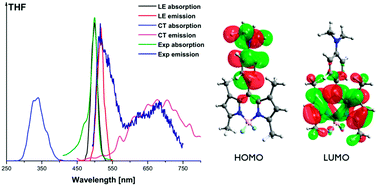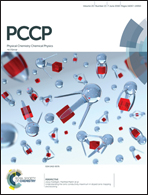Modelling absorption and emission of a meso-aniline–BODIPY based dye with molecular mechanics†
Abstract
Absorption and emission spectra of 8-(4-dimethylaminophenyl)-1,3,5,7-tetramethyl–BODIPY have been calculated using Coupled Cluster (CC) approaches, Time-Dependent Density Functional Theory (TD-DFT) and a QM-informed MM approach. In the case of TD-DFT calculations solvent effects were included using the linear-response (LR), corrected linear response (cLR) and state specific (SS) Polarizable Continuum Model (PCM). We show that range-separated functionals give results in reasonable agreement with coupled cluster methods but both tend to overestimate excitation energies. Furthermore, we show that the SS-PCM approach is unable to provide a quantitative description of solvent effects in these systems, especially for the highly challenging charge-separated charge-transfer state. In contrast, the QM-informed MM approach gives results in good agreement with experiment and we propose a scheme which can be used to directly compare theoretically obtained spectra with experimental ones.



 Please wait while we load your content...
Please wait while we load your content...